A True Revolution
By Nancy Redfeather
Coordinator of Hua Ka Hua Seed Symposium
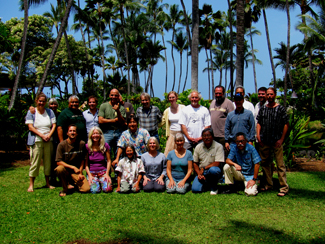
Photo: The core planning group for the Hua Ka Hua Seed Symposium.
The Kohala Center hosted over 100 farmers and gardeners from around the state, university researchers, and representatives from Organic Seed Alliance at the Hua Ka Hua Seed Symposium on April 17–18. Participants departed with new awareness and knowledge about the importance of seed, and the Symposium laid the groundwork for a future Hawai‘i State Public Seed Initiative. Mahalo to USDA/OREI, Hawai‘i County, and Kamehameha Schools Keauhou-Kahalu‘u Education Group for their support!
By the end of the Symposium, I became more aware than ever about the desperate state of seed today. We are all the sons and daughters of seed savers. Only a few generations ago, most of our ancestors participated some way in seed selection, improvement, and saving. We have gone so far in the opposite direction so fast—after 15,000 years of participation, we have lost much knowledge in less than 100 years. This is sad, because seed is the very foundation of all life and all food.
Not only have we lost knowledge, we don't even realize what we don't know. As agriculture became more and more integrated with the industrial systems of “modern” societies, corporations became increasingly interested in seed production and distribution. With the industrialization of seed production, uniformity of quality and kind was sought, which led to a reduction in regionally adapted diversity. 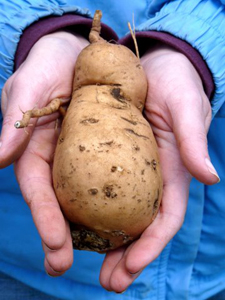 Ultimately, the business trends associated with industrial seed production could result in a continued narrowing of germ plasm to just a few patented varieties.
Ultimately, the business trends associated with industrial seed production could result in a continued narrowing of germ plasm to just a few patented varieties.
Photo: ‘Uala (sweet potato). Photo by Michael O’Brien.
Since biodiversity is key to resilient agricultural systems, this trend is worrisome. By working to revive a system of traditional plant breeding that includes open sharing of seed and plant germ plasm, we can expand the variety of plants which are available for a sustainable agricultural future. We must be able to dream of another world, in which human society and the natural world can truly flourish together through agriculture. We must rise up, awaken—E Ala E—and change. The time to change is now, and we are the ones who will decide the course of the evolution of the natural world. Which path will we take, after 4.5 million years of co-evolution between human society and seeds? We are truly at a crossroads.
I believe we, each of us who cares about the future of seed, must begin to practice saving seed, even on a very small scale. If we think seed is important, we should each start a small home garden and try saving one variety of something. And then we can have a truly green revolution, one that respects the environmental and cultural diversity of our communities in which the growing of food takes place, and one which preserves the diversity of seeds and plant life.
We can turn things around through rigorous and creative thinking, research, and action. This is what I dream of. Many people share this dream. Equally present at the Symposium was the incredible hope that we hold for the future.
Aloha,
Nancy
Videos and brief summaries of the Symposium presentations will be available on The Kohala Center’s Web site this summer. Look for an announcement in an upcoming Leaflet.

Wisdom of the Kūpuna

Photo: “Viewing the vast Hawaiian Field System from the top of Pu‘u Kehena looking down on a rainbow made me feel so proud of our kūpuna (Hawaiian elders) and so humble. I am grateful for all the wisdom they still share with us.” –Cindi Punihaole, Outreach and Volunteer Coordinator, The Kohala Center. Photo by Michael O’Brien.
Hawai‘i Island is a model system that helps us to understand how the world works in areas as diverse as evolution and the origin of species, the structure and functioning of ecosystems, and the development and sustainability of human societies. —Professor Peter Vitousek, Stanford University
Over 30 guests from around the island had the privilege of accompanying Professor Peter Vitousek on a field excursion to the Puanui Ahupua‘a (watershed) on Kohala Mountain on Saturday, March 27. Puanui lies within the Leeward Kohala Field System, a 25 square mile area that stretches from near ‘Upolu Point to Kahua Ranch. “Prior to European contact, Hawaiians developed a remarkable intensive agricultural system in this area, the remains of which are clear today,” explained Professor Vitousek. “We are trying to learn how this system worked by doing—by growing Hawaiian crops in several gardens within the ancient field system. We are also working to make the system accessible to the community, by using the land and the practices associated with it to bring both science and culture to students and the community,” he said.
Read more in "A Sweet Spot of Land" on the Back Page.

Consumer Energy Education
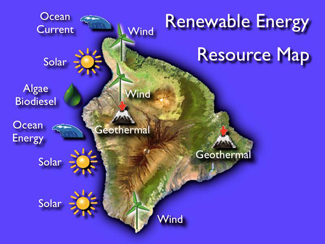
Photo: Hawai‘i County is blessed with the most diverse and abundant renewable resources in the world. The County of Hawai‘i is committed to utilizing these resources in an economical, culturally-sensitive, and environmentally-benign manner. Image and caption by Will Rolston, Energy Coordinator, County of Hawai‘i, and Keith Olson, Natural Energy Lab of Hawai‘i Authority (NELHA).
The County of Hawai‘i is providing a collection of consumer information to support local efforts to reduce reliance on fossil fuel. While we use less electricity per capita than the U.S. average, we also pay the highest electricity and fuel rates in the nation. With the right information, residents, businesses, and government can make energy decisions that save money and promote the sustained health and prosperity of island families and communities. —Randy Kurohara, Director, Hawai‘i County Department of Research and Development
Among the key recommendations to emerge from the Hawai‘i County Energy Sustainability Study Recommendations was that the County should develop and disseminate energy efficiency information to island residents, to encourage residents to make energy efficient choices in their daily lives and when purchasing vehicles and home appliances. The Energy Study highlighted that by making simple choices, such as purchasing compact fluorescent light bulbs, solar water heaters, and EnergyStar appliances, and using mass transit, we can significantly reduce our island’s dependence on imported fossil fuel. In 2008, the Hawai‘i County Council followed up on this Plan recommendation by allocating funds to the Department of Research and Development (R&D) to create consumer energy information for island residents. The County contracted with The Kohala Center to create a series of consumer education articles focusing on energy efficiency and including the following topics:
- Tips on energy saving practices for homeowners
- An explanation of a typical monthly electric bill
- Solar systems for the home
The County recently posted these articles online at its Web site. To access the information please visit http://www.hawaiicountyrandd.net/energy/downloads.
Hawai‘i County is also striving to improve the energy efficiency of its own internal operations. To this end the County is conducting facility audits, a County fleet analysis, wastewater facility audits, and day-to-day operations audits. The County is also actively supporting increased use of its mass transit system, including expansion of its fleet and bus routes and continuation of free bus service around the island. The County has sponsored 50 home energy audits and is working on an island-wide educational program to help residents conduct self audits of their homes and businesses. The County is also promoting energy efficiency rebates, as they become available, and is working to deploy alternative energy vehicles. Renewable energy projects currently underway include: a 400 kW photovoltaic (PV) array at the West Hawai‘i Civic Center in Kona (under construction), a 100 kW PV array at the Hawai‘i County Building in Hilo, a 34 kW PV array at Waimea Fire Station, a 48 kW PV array at Waimea Police Station, and a 20 kW PV array at Pahoa Police Station. For further information on these and other energy projects, please contact William J. Rolston, Hawai‘i County Energy Coordinator, at 808-327-3664 or via e-mail at wrolston@co.hawaii.hi.us.

Best in the Country
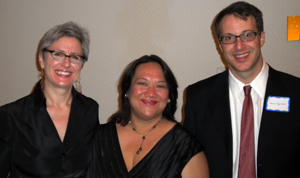
Photo: Dr. Noelani Arista received the Prize in a ceremony on April 10 at the Organization of American Historians Conference in Washington D.C. This photo of Arista (center) with her advisors Jane Kamensky and David Engerman was taken at the awards ceremony.
Dr. Noelani Arista, University of Hawai‘i at Mānoa Assistant Professor in History and 2008 Mellon-Hawai‘i Doctoral Fellow, has been awarded the prestigious Allan Nevins Prize by the Society of American Historians for the best-written doctoral dissertation on an American subject. Arista’s dissertation, “Histories of Unequal Measure: Euro-American Encounters with Hawaiian Governance and Law 1793-1827,” focuses on the early connections between Hawai‘i and New England and addresses questions of law and jurisdiction in early nineteenth-century Hawai‘i. As the prize-winning dissertation, this groundbreaking work will be considered by university presses for publication as a book.
Read "New Thinking for Hawai‘i and the World" on the Back Page.

Motivated Teens
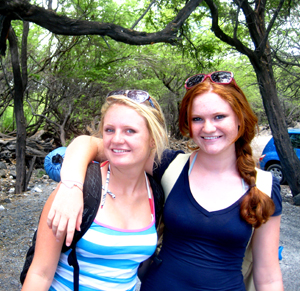
Photo: Sisters Dominique (left) and Megan Saks (right) are both BELL Rhode Island scholarship recipients.
Two years ago, my sister, Dominique Saks, participated in BELL. Upon returning, Dominique and Amber Datta, who also went, created a youth environmental leadership group called YEL (Youth Environmental Leaders). About ten motivated and passionate teens, including myself, made up this group. With the support and mentorship of TREE Hawai‘i, we brainstormed environmental improvement ideas, re-fenced an area of forest susceptible to the appetites of sheep and the destruction caused by pigs, cleaned up hiking trails, fundraised, and attended a Hakalau Wildlife Refuge Open House. —Megan Saks, sophomore at Kealakehe High School and 2010 BELL Rhode Island scholarship recipient
The Kohala Center congratulates our three 2010 summer scholars—Megan Saks, Alyssa Evans, and Roya Sabri. Megan and Alyssa will travel to Narragansett, Rhode Island to participate in the BELL (Brown Environmental Leadership Lab) Sustainable Development Program. For the past several years, The Kohala Center has partnered with Brown University to send motivated Hawai‘i Island high school students to this prestigious environmental leadership program. Megan tells us that her sister and four friends have attended previous BELL Programs, and she is “honored and excited to carry on the ‘legacy’.”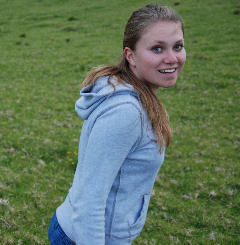
Photo: Alyssa Evans.
The only clear thing is the fact that people, in general, are using resources unreasonably and that the problems and the solutions to the problems affect more things than we realize. This year I am taking an Environmental Science class and have learned a great deal about what sustainability actually means and how policy, leadership, science, business, and even culture are all interconnected when it comes to sustainable and non-sustainable practices. —Alyssa Evans, junior at HPA and 2010 BELL Rhode Island scholarship recipient
Roya Sabri will travel to the Cornell University campus in Ithaca, New York to participate in the CATALYST Academy. Roya was first introduced to The Kohala Center last summer, through her participation in the Student Congress on Sustainability at HPA. “There, I learned from businesses and individuals how to become more sustainable and was inspired to get involved in projects that are aimed at creating a sustainable future.” After the Congress, Roya helped to start a recycling club at Kealakehe High School, and she began volunteering her time as a ReefTeacher at Kahalu‘u Bay. Read more about Roya’s experience as a teen ReefTeacher in "Hoping to Make a Difference” on the Back Page.
Along with partial support from university partners, donations from The Kohala Center’s Circle of Friends help to provide Hawai‘i Island youth with these opportunities to join environmental leadership programs at Brown University and summer engineering programs at Cornell University.

Waimea Nature Camp:
Forests, Tide Pools, & Everything in Between
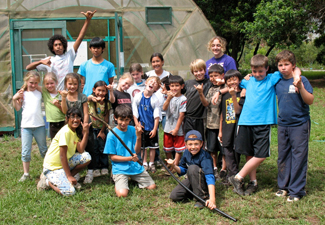
Photo on the right: Waimea Nature Campers gather for a group shot in March 2010.
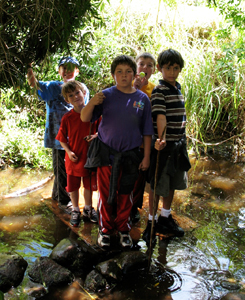 Waimea Nature Camp invites boy and girls in grades 2–8 to explore the streams, the forests, the tide pools, and the geology of our island home this summer. Four week-long sessions are planned: June 14–18 is Stream Week, June 21–25 is Forest Week, July 12–16 is Tide pool Week, and July 19–23 is Rock Week. Middle schoolers are welcome to sign up for any of these four sessions. Students in grades 6–9 are also invited to a special HI-MOES Summer Science Camp on June 28–July 2.
Waimea Nature Camp invites boy and girls in grades 2–8 to explore the streams, the forests, the tide pools, and the geology of our island home this summer. Four week-long sessions are planned: June 14–18 is Stream Week, June 21–25 is Forest Week, July 12–16 is Tide pool Week, and July 19–23 is Rock Week. Middle schoolers are welcome to sign up for any of these four sessions. Students in grades 6–9 are also invited to a special HI-MOES Summer Science Camp on June 28–July 2.
Photo on the left: Spring 2010 campers on their unsinkable raft. (From left to right) Jacob Schnitzler, Brendan Moynahan, Wyatt Madonna, Thierry Devost, and David Welch Keliihoomalu.
Campers can sign up for more than one session, but space is usually limited as we try to accommodate as many kids as possible. Camp runs from 9 a.m. to 3 p.m., Monday through Friday. The cost for each week-long session is $100 per camper.
Applications are available online at http://www.kohalacenter.org/WaimeaNatureCamp/about.html. Applications are due on May 19, with placement letters sent out on May 24.

Laulima: Working Together

Photo: Members of the Honoka‘a High School FFA Club pose in front of the greenhouse at the Hakalau Forest National Wildlife Refuge. (From left to right) Patti Connors, Keleb Palignawan, Kaliko Pajimola, James Maikui, horticulturist Baron Horiuchi, Kaimana Lutey, James Marlin, and Kaniela Heincke.
Seven members of the Honoka‘a High School Future Farmers of America (FFA) Club journeyed to the U.S. Fish and Wildlife Service’s Hakalau Forest National Wildlife Refuge on Mana Road for a weekend service learning project in March. Students worked with horticulturist Baron Horiuchi in the refuge’s greenhouse, maintaining and planting native plants. The group hiked into the pristine native rainforest at the refuge, where they spotted rare Native Hawaiian birds like the i‘iwi.
I learned that caring for the rare Hawaiian birds and plants is an important part of the FFA because we are a group of people who are trying to bring back the endangered species that lived here on the Hawaiian Islands. By volunteering, I learned a lot about the native plants, like the Hawaiian mint, and the rare birds that we got to see. I had a lot of fun and would enjoy going back one day. I will never forget the time we had there.
—Kaniela Heinicke, Honoka‘a High School senior and president of the Honoka‘a FFA Club
Read "Firsthand Knowledge" on the Back Page.


Subscribe to Kalei Nu‘uhiwa's Hawaiian Moon Newsletter.
Please click here and then send from your e-mail. Mahalo!

